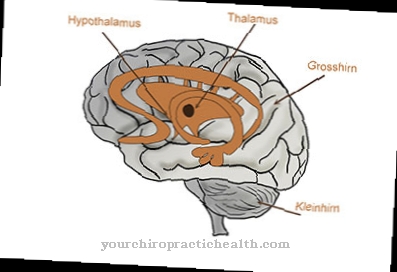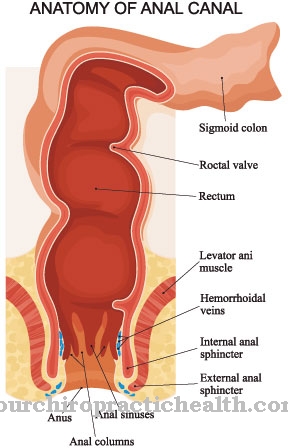Neurofibromatosis type 1 is a genetic disease for which malformations of the central nervous system and the skin are characteristic. With around one in 3000 newborns, type 1 neurofibromatosis is one of the most common genetic diseases.
What is neurofibromatosis type 1?
© peshkova - stock.adobe.com
As Neurofibromatosis type 1 (also Recklinghausen's disease) is a genetic phacomatosis with malformations in the skin and central nervous system.
Neurofibromatosis manifests itself on the basis of pigment anomalies that already occur in infancy, such as spots with a coffee-brown color (café-au-lait spots or milk coffee spots) and axillary and inguinal lentigines (freckle-like pigmentation in the armpits and groin).
Another key symptom of neurofibromatosis type 1 are the neurofibromas that can be found all over the body of the person affected. Neurofibromas are benign (benign) tumors that occur in most cases in childhood and can lead to pain and neurological deficits such as paresthesia if, in addition to the skin, internal organs, in particular the spinal cord nerves and the brain, are affected.
In addition, with neurofibromatosis of this type, bone abnormalities such as scoliosis (curvature of the spine), Irish amartoma (Lisch nodules on the iris and the anterior eye) and learning and concentration difficulties are possible symptoms.
causes
A Neurofibromatosis type 1 is due to mutative gene changes, whereby Recklinghausen's disease has a mutation of the so-called NF-1 gene (neurofibromatosis 1 gene) on the 17th chromosome, which leads to uncontrolled cell proliferation (cell reproduction and growth).
The mutation responsible for the manifestation of the disease is either passed on from one parent to the child via the autosomal dominant inheritance or develops as a result of new mutations as spontaneous changes in the genome of the affected person (in around 50 percent of cases).
It is not yet known which factors trigger these mutative processes. It is assumed that the size of the affected chromosome, which increases the likelihood of mutations, plays a decisive role.
Symptoms, ailments & signs
Type 1 neurofibromatosis is primarily characterized by different, mostly benign skin changes. This includes excessive pigmentation of the skin, which can already occur in babies and newborns. Their shape is often oval, while the color is vaguely reminiscent of milk coffee. That is why these are also known as café-au-lait spots in medicine.
Freckle-like speckles occasionally appear in the armpits, groin, or even the lining of the mouth. When the disease progresses, benign nodules grow on the surface of the skin, some of them considerable in size, several centimeters from the age of ten. These neurofibromas also occur spontaneously in pregnancy.
As a rule, the tumors and skin lesions do not cause any pain or other discomfort.Therefore, apart from the aesthetic impairment, those affected expect a healthy and suffering-free life course. The growth of neurofibromas is not restricted to the skin surface. They can also be developed on the iris or within the body. Benign tumors on the optic nerve obstruct vision (optic glioma).
Nerve fiber tumors and curved bones (scoliosis) also put a strain on performance. Learning problems and a loss of concentration are the result. In extreme cases, the growths can also cause epileptic seizures. In a milder form, visual disturbances, symptoms of paralysis or a general tendency to abnormal sensations can be observed. Type 1 neurofibromas very rarely develop into malignant tumors and accordingly cause pain to sufferers depending on their location.
Diagnosis & course
A Neurofibromatosis type 1 is diagnosed based on the symptoms characteristic of the disease such as café-au-lait spots, neurofibromas, multiple lentigines, Lisch nodules. The underlying mutation on chromosome 17 (NF-1 gene) can be detected in the course of a DNA analysis.
A familial accumulation of the disease can also indicate neurofibromatosis. If the specific mutation in the family is known, this can be determined prenatally by means of a chorionic villus sampling or an amniotic fluid test. Imaging methods such as x-rays (scoliosis) or electroencephalography (impairment of the brain) are used to determine whether internal organs are involved.
Although the courses can vary greatly even within the family, neurofibromatosis has a mild course in the majority of cases (around 60 percent). If left untreated, neurofibromatosis can lead to pronounced impairments such as tumors of the optic nerve or the brain.
Complications
Whether or not there are complications in neurofibromatosis type 1 varies greatly. Some cases of illness take a mild course, while other sufferers can have serious consequences. For this reason, regular check-ups are extremely important because the doctor can identify any effects that require treatment at an early stage.
The so-called partial performance disorders are among the most common sequelae of neurofibromatosis type 1. This leads to learning difficulties in children who are actually of normal intelligence. About half of all sick children are affected by learning problems. It is not uncommon for behavior disorders, attention deficits or hyperactivity to occur in parallel. However, there is no deterioration in the learning difficulties. The affected children should be supported before they start school.
Another consequence of neurofibromatosis type 1 is the appearance of neurofibromas under the skin. In some patients, they appear in childhood, in others only in puberty. Existing neurofibromas can grow during puberty. Neurological disorders or pain are possible, depending on which part of the body the tumors appear.
Curvatures of the spine or scoliosis are also widespread among neurofibromatosis patients. They are more common in neurofibromatosis than in healthy people. Serious complications are brain tumors or tumors of the optic nerve such as optic gliomas. In addition, epileptic seizures are possible.
When should you go to the doctor?
Parents who notice the typical skin changes in their child should contact their pediatrician immediately. Medical advice is required at the latest when growths or nodules form on the skin. The doctor can diagnose type 1 neurofibromatosis and initiate treatment immediately.
If the skin lesions become infected, the child must receive medical attention the same day. If there is a fever and other accompanying symptoms, an in-patient examination in the hospital is necessary. In addition to the family doctor or pediatrician, neurofibromatosis type 1 can be seen by a dermatologist, neurologist, neurosurgeon or other internist.
The actual therapy usually takes place in a specialist clinic for skin diseases. In order to ensure optimal care, interdisciplinary advice can be useful. Since the disease can also represent a considerable burden for the parents, therapeutic advice is always useful. After completing treatment, the child must be examined by a doctor at least once a year. The doctor can clarify whether new tumors have developed and examine the internal organs as well as the eyes and ears for further damage.
Treatment & Therapy
Because the underlying cause is a Neurofibromatosis type 1 is genetic or mutative, it cannot be treated causally. The therapeutic measures are aimed at reducing the specific symptoms and preventing potential secondary symptoms.
Neurofibromas that cause impairing pain and / or have a risk of degeneration are usually removed (micro) surgically as part of a surgical procedure. The tumors can be removed with a scalpel, a laser or as part of an electrocautery. While neurofibromas located above the skin level are cut out with a scalpel, cutaneous tumors or tumors located at the skin level can be removed with the laser or by electrocautery.
The latter enables hemostasis to be accelerated at the same time due to the effect of heat, which is a decisive advantage, particularly in the case of neurofibromas that are rich in blood vessels. In principle, however, a comprehensive risk-benefit analysis should be carried out in advance of the procedure, since every surgical procedure can lead to paralysis as a result of a functional failure of the proximal nerves.
In addition, tumors in the area of the central nervous system can be located unfavorably, so that even healthy tissue structures can be damaged by a surgical intervention. Radiotherapeutic measures for degenerated tumors should also be carefully examined due to the increased risk of further degeneration.
Last but not least, symptoms of type 1 neurofibromatosis such as epilepsy (carbamazepine, clonazepam), poor concentration (change in diet, concentration exercises) or scoliosis (physiotherapy, corset, surgery) must be treated.
Outlook & forecast
People with type 1 neurofibromatosis suffer from an incurable disease. A genetic defect was found to be the cause of the health problem. Since interventions and changes in human genetics are not permitted due to legal requirements, no healing can take place. This represents a considerable burden for those affected and their relatives. In medical care, doctors concentrate on alleviating the existing and individually pronounced symptoms. In addition, one aim of treatment is to control the progression of the disease.
Thanks to medical advances, there are now various treatment approaches that lead to significant symptom relief. Regular medical monitoring is also used as a preventative measure for any complications. In many cases, impairment of sensory perception and motor disorders are to be expected. Failure to seek medical treatment increases the risk of serious sequelae. In addition, the general quality of life is significantly impaired.
In many cases, those affected require intensive daily care, as coping with everyday life is not feasible for them alone. Patients usually have to undergo repeated surgical interventions in the course of their lives. Tissue overgrowths should be removed in these so that symptoms of failure can be reduced or existing complaints can regress.
prevention
There Neurofibromatosis type 1 is a genetic or mutative disease, it cannot be directly prevented. To prevent complications, however, regular check-ups should be carried out so that therapeutic measures can be initiated in good time, especially if neurofibromas are present that can degenerate into lymphomas or neurofibrosarcomas.
Aftercare
In the case of neurofibromatosis type 1, in most cases only very few and only very limited measures and options for follow-up care are available to the person affected. For this reason, those affected with this disease must consult a doctor very early to avoid other complications or complaints. As a rule, self-healing cannot occur.
Due to the genetic disease, there is also no complete cure. Therefore, if the person concerned wants to have a child, he should definitely have a genetic examination and counseling carried out in order to prevent the recurrence of neurofibromatosis type 1 in the children. During treatment, those affected are mostly dependent on the help and support of their own family.
It is not uncommon for psychological support to be necessary to prevent depression and other psychological upsets. In many cases, children with neurofibromatosis type 1 also need intensive support in school so that complications do not arise in adulthood. Physiotherapy and physiotherapy measures are also very important, and many of the exercises from these therapies can also be performed in your own home.
You can do that yourself
The pigment changes that often occur in connection with neurofibromatosis type 1 can be treated cosmetically by the patient himself, for example with appropriate creams. Parts of the body that are prone to changes in pigmentation should be avoided from intense sunlight.
The mental impairments occasionally associated with neurofibromatosis type 1 (e.g. partial performance disorders, behavioral problems or motor restrictions) can be carried out independently with appropriate therapies - if instructed by a therapist. In addition to conventional medical care, the most important pillar are self-help groups. Self-help groups offer the patient a wide range of offers, such as providing therapy, explaining the course of the disease and its forms of treatment, and offering advice and support, for example, on the question of a genetic examination of a fetus in pregnancy. There are self-help groups in every federal state.
Type 1 neurofibromatosis progresses differently in each patient; Living with uncertainty - when will neurofibromatosis type 1 break out, what exactly will happen then - is inevitably part of the patient's life. It is advisable, possibly with the support of a suitable therapist, to find ways out of this unsatisfactory situation in order to be able to integrate the uncertainty into everyday life.



.jpg)
.jpg)
.jpg)


















.jpg)



